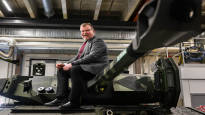ÖRNSKÖLDSVIK Sweden’s military equipment industry is making record results as a result of Russia’s war of aggression, as countries strengthen their defenses and replace supplies sent to Ukraine.
It can be seen and felt in the center of Örnsköldsvik with a population of 55,000. The factory of defense equipment manufacturer BAE Systems Hägglunds is located in the city.
At midday, only older people are out and about, because, among other things, as a result of Hägglunds’ hundreds of new jobs, the city’s unemployment rate has dropped to six percent in two years, which is below the average for the whole of Sweden.
In Örnsköldsvik market, Swedish and Ukrainian flags fly side by side. The distance to the capital of Ukraine, Kyiv, is about 1,600 kilometers as the crow flies. Ukraine is at war, but the thoughts of the people of Örnsköldsvik are divided.
– We don’t like the war in Ukraine at all. But it’s good for the city that Hägglunds is doing well. Many jobs will be created, Leif Söderlind line.
Hägglunds is the largest company in Örnsköldsvik. It was originally a family business, which over time has developed into one of the world’s leading manufacturers of Combat Vehicles.
Now the company is owned by the British, but its headquarters are still in Örnsköldsvik, which the locals are very proud of.
– Yes, we talk about it and are proud of it. We are proud that it is right here in Ovik, says Tina Liv and uses a colloquial abbreviation for the city.
The Russian threat started turning into orders already in 2014
CEO of Hägglunds Tommy Gustafsson-Rask is an energetic and good-natured former professional soldier who does not hesitate to climb on top of the CV90 assault armored vehicle displayed at the trade fair to be photographed.
The model is in use in numerous NATO countries, including the Finnish Defense Forces.
The Hägglunds factory has the same practice as at least another large Swedish military equipment manufacturer, i.e. Saab. Production lines are shown, but nothing can be photographed.
So we saw how slow, water-assisted drills cut thick wagon bottom plates and how the new laser drills cut thin steel as cleverly as a tailor’s scissors.
According to Gustafsson-Rask, Russia’s growing threat began to appear in order books nine years ago, i.e. after the annexation of Crimea. The attitude towards Russia changed. According to Gustafsson-Rask, it was found to be a threat against which the states began to equip themselves.
However, the pace of orders has accelerated to record levels after Russia invaded Ukraine last year.
– The war has made the states more determined. Decisions are made quickly, but the underlying threat is the annexation of Crimea. Orders directly related to the war in Ukraine are only starting to arrive now, says Gustafsson-Rask.
He refers to a recent order from Germany, which is based on Germany’s historic decision to increase its defense spending a year ago.
Number of employees doubled, production sixfold?
Gustafsson-Rask describes the current order backlog as historic.
The company’s number of employees has already almost doubled and is now well over 1,500. Additional people are still being hired. The visitors are mainly from other local companies. The employee must be a Swedish citizen, but does not have to be Swedish by birth.
Hägglunds is currently investing one hundred million euros in Örnsköldsvik, which will, among other things, renew production lines and build office space.
Hägglunds manufactures chassis for assault tanks, known generically as CV90. The model can be equipped in different ways according to the customer’s needs.
Patria’s tower was installed on the model commissioned by Finland. Finland placed its order in 2004, and at that time the unit price of the wagon was around 2.7 million euros.
In addition, armored all-terrain vehicles are manufactured in Örnsköldsvik, which are tuned under the name BvS10.
According to Gustafsson-Rask, the number of employees in Örnsköldsvik will no longer be increased by perhaps a few tens or hundreds. However, jobs are known for at least the next ten years.
But in the plans of the CEO, the production may have to be increased sixfold in order to be able to accept all the orders. The Örnsköldsvik factory can’t do that, not even though the welders now work in four shifts.
Gustafsson-Rask is finding a solution in the old customer countries. Old contracts often had a clause according to which part of the trade had to be done as industrial cooperation, i.e. in the customer’s country.
This has been done, for example, in Norway, which does not currently have orders inside. But the old know-how is stored. Therefore, some of Hägglunds’ new orders may be made to new buyer countries in Norway.
According to Gustafsson-Rask, similar arrangements can be set up for other former buyer countries.
The need for foreign labor is great
Chairman of the Örnsköldsvik City Council Anna-Britta Åkerlind reminds that Örnsköldsvik has a long industrial tradition and with that the entrepreneurs have a good self-esteem.
Hägglunds’ ferocious need for labor that has lasted for a couple of years is not yet reflected in the population, but the centrist municipal decision-maker is staggered by Ulf Kristersson the right-wing government’s intentions to limit the access of foreign labor to Sweden. Although people coming from abroad cannot be employed by Hägglunds before obtaining citizenship, they are needed in other workplaces in the municipality.
– The need for labor is really great, and I feel that the government and the Finnish Immigration Service do not understand how important the availability of labor is to the development of Sweden as a whole and especially Northern Sweden.
Örnsköldsvik’s population is getting older, but in recent years the loss of migration has turned into a small increase.
You can discuss the topic on Wed 3.5. until 11 p.m.
